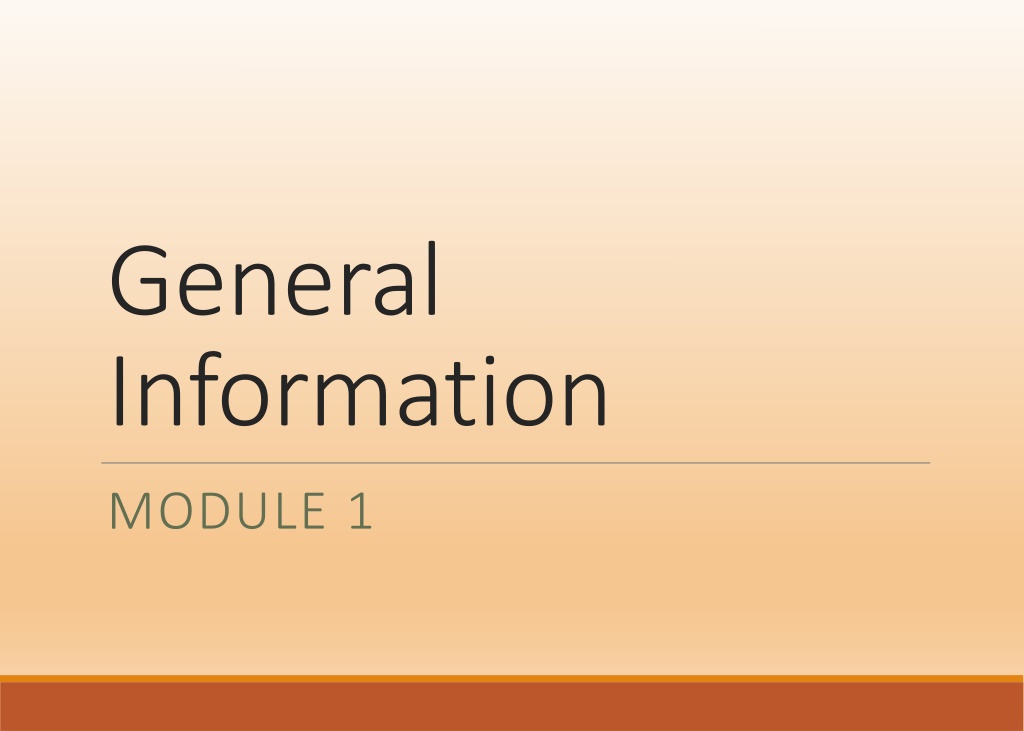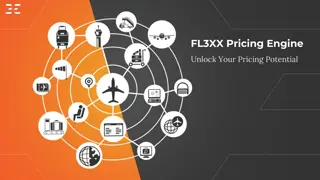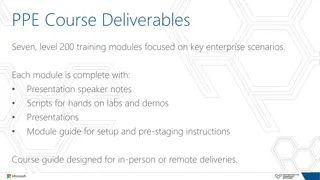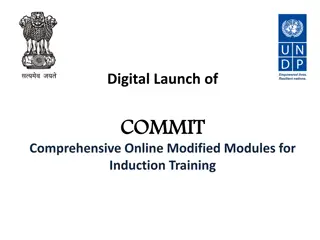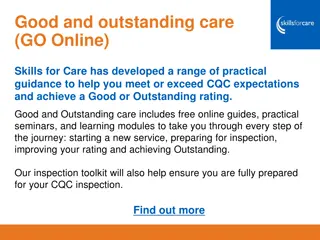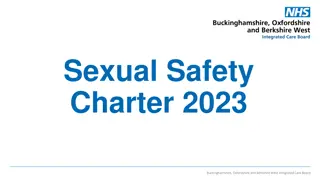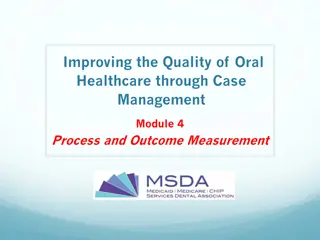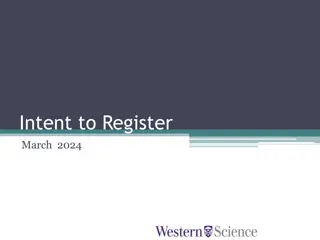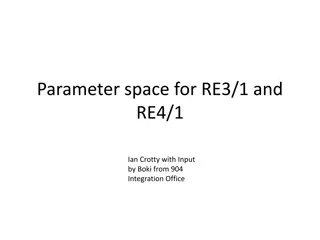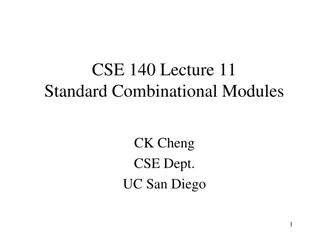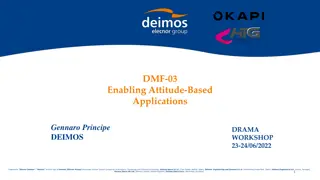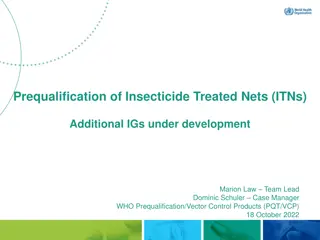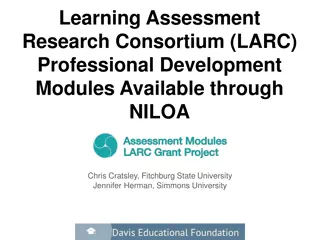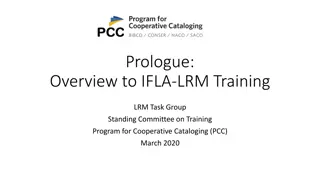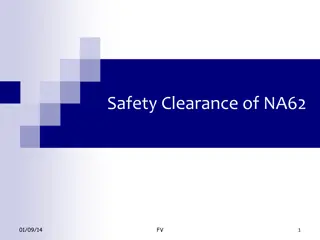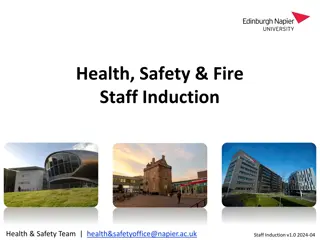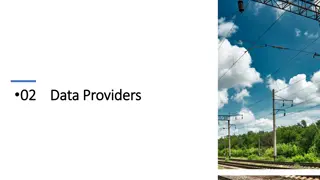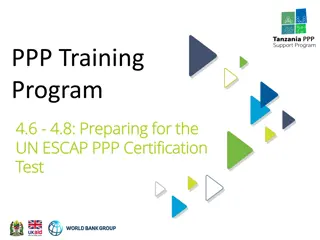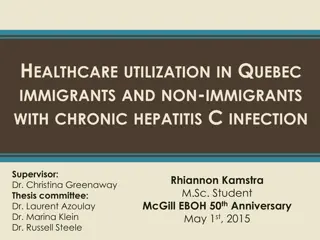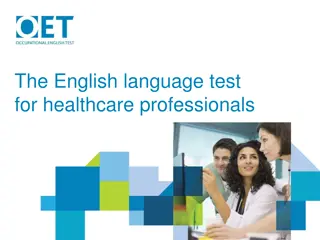Healthcare and Safety Training Modules
Mission, Vision & Values focus on quality healthcare and community wellness. Evidence-Based Practice ensures optimal patient care. Patient Harm Reporting emphasizes safety. Learn about Back Safety to prevent back pain and improve health. Understand electricity and fall safety hazards. Engage with interactive assessment questions to reinforce learning.
Download Presentation

Please find below an Image/Link to download the presentation.
The content on the website is provided AS IS for your information and personal use only. It may not be sold, licensed, or shared on other websites without obtaining consent from the author. Download presentation by click this link. If you encounter any issues during the download, it is possible that the publisher has removed the file from their server.
E N D
Presentation Transcript
General Information MODULE 1
Mission, Vision & Values Mission: To provide quality healthcare and foster health and wellness in our communities. Vision: The preferred provider for high quality care, creating better health in our communities and recognized for excellence in all that we do. Values: Patient First Respect Transparency Accountability Creativity Collaboration
Evidence-Based Practice Evidence-Based Practice is providing the best individualized patient care based on the most current research. Steps include identifying a condition, letting research guide our treatments, and changing internal processes to improve outcomes.
Patient Harm Reporting Any adverse events, close calls or near misses that did or could cause harm, should be reported. This includes hazardous or unsafe conditions that increase the chance of an adverse event occurring. All reports are routed to the Director of Patient Safety using the Incident Reporting System, within 24 hours. Always include the persons involved, time, place, all pertinent facts about what happened, and what actions were taken. Please contact your director if you need assistance with this.
1. Evidence Based Practice is providing the best individualized patient care based on the most current research. Circle True or False on answer sheet Module 1 Questions 2. If there is an incident causing patient harm, the Director of Patient Safety is alerted with an Incident Report. Circle True or False on answer sheet
General Safety MODULE 2
Back Safety Back pain is due to the way we eat, sleep, sit, walk, lift and play sports. It s can also be due to poor posture, driving or riding, trauma, lack of exercise and poor nutrition. Keep your back healthy by using the right moves: Bending: Correct posture, change positions frequently, bend down on one knee if necessary and keep the load close to your body. Lifting: Firm footing, feet shoulder width apart, use your hips and legs (not your back), load close to body, tighten stomach muscles, knees bent, back in neutral position and chest forward. Pushing: Use both arms, elbows bent, tighten stomach muscles, stay close to load, and keep a straight back. Improve your back health safety by knowing your limits, getting help when needed and exercising regularly.
Electricity & Fall Safety The 5 primary hazards of electricity are: shocks, burns, arc-blast, explosions and fires. Frayed cords, unsafe use of equipment and unsafe work practices are all causes of electrical accidents. All electrical apparatus must be approved by Maintenance (x8801) before use. Fall hazards can include wet floors, frayed carpets, cords, clutter, rushing and improper shoes.
Hazardous Material Safety The Hazardous Chemical Information Act a.k.a. the Right to Know law requires work places to tell employees and volunteers about the effects of exposure to hazardous chemicals. If you encounter a chemical spill, call the house supervisor and maintenance immediately. They can determine if clean-up can be done in- house or if Asheboro Fire Department help is needed.
Radiation & MRI Safety All radioactive materials and radiation-generating devices must be labeled with the universal symbol. Only properly trained personnel should handle materials or devices labeled as such. Be aware of radiation symbols on doors and equipment. If necessary, ask staff in Diagnostic Imaging about areas to avoid. All MRI departments are required by the Joint Commission and ACR to have clearly marked safety zones for patient and staff safety. Only patients and staff that have been trained, screened or are escorted, are allowed into zones III and IV. One of the main causes of accidents is the failure to realize that the magnet is ALWAYS on, even if the hospital loses power.
Personal Safety Wear your name badge. Be alert and continuously aware of your surroundings. If you see someone loitering, politely approach them in case they need directions. If not, make a mental note of their description and location and call security. Security is available 24 hours a day patrolling the building and parking deck. Call their extension x3110 or call the operator and have them paged.
Crisis Behavior Use S-T-A-M-P to recognize early warning signs that a person s behavior is getting out of control: Staring and eye contact Tone and volume of voice Anxiety or agitation Mumbling Pacing Don t isolate yourself with a potentially violent person. Remove yourself from the situation. Present a calm, caring attitude. Acknowledge the person s feelings. Don t match threats and don t give orders. Avoid behavior that may be interpreted as aggressive. Always keep an open path for exit. Don t handle a dangerous situation alone. Call security x3110 or x4444 for emergencies.
Reporting Job Injuries Document with Director of Volunteer Services before you leave for the day. Call or email Employee Health (EH) within 24 hours. Submit completed Occupational Injury Report found on RHINO and at the EH door (Floor M) to Employee Health before next volunteer shift.
In-Person Emergencies* If a visitor OR employee comes to you having a medical emergency, call x4444 and state Rapid Response and the location. The House Supervisor will come to your location, assess the situation, and escort the person to the Emergency Department as warranted. Don t call the ED yourself or tell the person having the emergency to call the ED.
1. When lifting, you should: a) Keep the load close to your body b) Lift, turn and twist c) Bend over and pull 2. If you are injured during your shift, the incident should be reported the same day to the Director of Volunteer Services. Circle True or False on answer sheet Module 2 Questions 3. If an employee collapses near you, call x4444 and state your location. Circle True or False on answer sheet What are the signs that indicate a person may 4. become violent? a) Staring and eye contact b) Tone and volume of voice c) Anxiety or agitation d) Mumbling e) Pacing f) All of the above 5. Any electrical apparatus brought into the hospital must be approved by Maintenance before use. Circle True or False on answer sheet
Patient Safety MODULE 3
National Patient Safety Goals The National Patient Safety Goals for Hospital, Laboratory and Home Health Programs have been developed primarily to improve patient safety.
Preventing Patient Falls Identification of patients at high risk for falls include: Yellow wristband Non-skid footwear Fall precaution sign on door frame Sign over head of bed If a patient has been identified as being high risk for falls and is seen getting out of bed or walking without assistance, they should be assisted safely to a bed or chair. Then notify a nurse or nurse tech immediately.
Patient Abuse Patients have a right to a safe environment in the hospital. Any type of abuse of a patient by a healthcare provider is a breach of medical ethics and a violation of Randolph Health s policy on Professional Behavior and Standards. Certain violations of this policy such as assault or sexual abuse are also crimes that can result in imprisonment. In order to protect our patients, criminal background checks are a part of the hiring process for Randolph Health employees. The Joint Commission requires facilities do the following: Educate staff about signs and symptoms of abuse. Identify victims of abuse and refer to appropriate outside agencies. Maintain a list of agencies for referral. Report abuse and neglect according to state and local law.
Identifying Signs of Abuse Volunteers may encounter any of the following signs of self-abuse or abuse by others when assisting patients: Evidence of alcohol or drug abuse Vague physical or psychological complaints Visible injury to any part of the face, neck or throat Observed emotional abuse or marital discord Support person(s) reluctant to leave the victim alone with medical staff Patient reports of abuse Any alleged cases of suspected child, disabled adult, or elderly abuse must be reported to the Department of Social Services Adult/Child Protective Services. If assistance is needed with the referral, contact the Case Management Department.
1. The main purpose of the National Patient Safety Goals is to improve patient safety? Circle True or False on answer sheet Module 3 Questions 2. Identification of patients at risk for falls include: a) Yellow wristband b) Sign on door frame and above bed c) Non-skid footwear d) All of the above
Fire Safety MODULE 4
If you detect fire Call out, find and pull nearest fire alarm, and call x4444. Using a Fire Extinguisher Pull the pin Aim the nozzle at the base of the fire Squeeze the handle Sweep the extinguisher back and forth
If you hear a fire alarm All corridor traffic must stop! Close all doors Keep visitors in your immediate area until All Clear announcement is made Do not allow anyone to use the elevator Assist staff as you are able in R-A-C-E Rescue removing anyone in immediate danger Alarm call out Fire Alarm (location) , pull nearest alarm box, call x4444 and report Fire Alarm Room # Confine close doors and windows in area where fire is located Extinguish extinguish fire, if possible, with a fire extinguisher, otherwise evacuate
1. The four steps of the RACE fire response plan are Rescue, Alarm, Confine, and Extinguish Circle True or False on answer sheet Module 4 Questions 2. The three steps involved in reporting a fire are calling out, pulling the nearest fire alarm and calling x4444. Circle True or False on answer sheet 3. When the fire alarms sounds, all corridor traffic must stop including staff, volunteers, and visitors. Circle True or False on answer sheet
Patient Rights MODULE 5
EMTALA EMTALA is the Emergency Medical Treatment and Active Labor Act. Any person requesting assistance for a potential emergency medical condition will receive a screening, performed by a qualified provider, to determine whether an emergency exists regardless if they can pay. Persons with emergency medical conditions will be treated and their condition stabilized without regard of ability to pay for services.
Advance Directives (pt. 1) There are two (2) types of Advance Directives: An Advance Directive Regarding A Natural Death, commonly called Living Will , and, Health Care Power of Attorney. Advance Directives (AD) come into force when the person who has executed the AD loses their decision making capacity. As long as the person has cognitive ability, they are their own medical decision maker even though they may have an AD in place.
Advance Directives (pt. 2) The Spiritual Care staff is responsible for reviewing advance directives with interested patients from 9:00 4:00 weekdays. If a patient desires Advance Directives information, a referral is ordered. Chaplains respond to referrals within 24 hours of request. The following are NOT Advance Directives: DNR: Do Not Resuscitate form MOST: Medical Order for Scope of Treatment form from and signed by an MD, PA or NP, and patient or patient representative Durable Power of Attorney Last Will and Testament
1. Who at Randolph Health is responsible for reviewing Advance Directives? a) Any Randolph Health employee b) Spiritual Care staff c) Security Personnel Module 5 Questions 2. EMTALA applies to any person who walks in to the emergency department and requests medical evaluation regardless if they can pay for services. Circle True or False on answer sheet
Cultural Diversity MODULE 6
Cultural Diversity Values If someone looks Hispanic/Latino, DON T assume they only speak Spanish. Accepting and appreciating differences among people. Understanding our fellow volunteers and coworkers. Working together as a team. Acknowledging the strengths and weaknesses of each person.
Communication Differences Depending on the culture, a person might favor or be offended by: Eye contact Gestures Certain tones and volume of your voice Standing too close or too far away Watch and listen to the other person for clues and tailor your responses if possible. If you accidentally offend someone, apologize. It s impossible to know social customs of every culture but everyone should be treated with fairness and respect.
1. Cultural diversity means: a) To accept and appreciate different people b) Understand our coworkers c) Working together as a team d) Acknowledging the strengths and weaknesses of each person e) All of the above Module 6 Questions 2. Which of the following communication approaches does NOT differ across different cultures? a) Loud tone of voice b) Maintain eye contact c) Treating others with fairness and respect d) Gesturing 3. I should assume people who look Hispanic or Latino only speak Spanish. Circle True or False on answer sheet
Sexual Harassment MODULE 7
What is sexual harassment? Sexual advances Requests for sexual favors Conduct of harasser is sexual in nature and unwelcome Sexual harassment in work places can include actions that imply Quid Pro Quo or create a hostile environment. Supervisors are prohibited from firing, demoting or causing difficulties for anyone who complains of harassment or who supports the complaints.
Volunteer Responsibility Review the sexual harassment policy Know what sexual harassment means Do not harass co-workers Complete the sexual harassment education module annually If you re a victim: Confront the harasser directly Tell the harasser their conduct is unwelcome and must stop File a complaint If harassment does not stop, report to the Director of Volunteer Services or Human Resources
1. Sexual Harassment occurs when the conduct of the harasser is sexual in nature and unwelcome. Circle True or False on answer sheet Module 7 Questions 2. If you feel you have been harassed, it is your responsibility to confront the harasser, tell them their conduct is unwelcome and must stop, and file a complaint. Circle True or False on answer sheet
Infection Prevention MODULE 8
Breaking the Chain Elements of the Chain of Infection are: Infectious Agent (organisms) Source (reservoir) Portal of Exit Mode of Transmission Portal of Entry Susceptible Host The weakest link, and the easiest to break, is the Mode of Transmission.
Patient Precautions Standard Precautions are used for ALL patients to prevent infection. Transmission-Based Precautions are used to prevent the spread of other infectious or drug resistant organisms, and include: Contact Precautions, Droplet Precautions, and Airborne Precautions. Volunteers should never enter rooms marked as precaution rooms.
Hand Hygiene (Washing) Turn on the water (warm water) Wet your hands Dispense soap into your hands (no bar soap for healthcare workers) Work up lather and use friction to clean surface of hands (between fingers, back and front of hands, thumbs, and under fingernails) for at least 20 seconds Rinse well, keeping hands directed down Dry hands thoroughly starting with fingertips, progressing to wrists Use paper towel to turn off faucet When wearing gloves, clean hands before putting them on
Hand Hygiene (Sanitizer) Alcohol based hand gels may be substituted for hand-washing with soap and water when hands are not visibly soiled When using alcohol-based hand sanitizer: Put product on hands and rub hands together Rub all surfaces until hands feel dry This should take around 20 seconds When wearing gloves, clean hands before putting them on
1. Which precaution applies to ALL patients? a) Contact precautions b) Airborne precautions c) Standard precaution d) Droplet precautions Module 8 Questions 2. Volunteers should not enter precaution rooms. Circle True or False on answer sheet
HIPAA and Corporate Compliance MODULE 9
What is HIPAA? HIPAA is the Health Insurance Portability and Accountability Act, passed in 1996. It demands use of Protected Health Information (PHI) ONLY when: Treating patients Obtaining payment for treatment Improving healthcare operations PHI includes: Demographic: name, address, phone/fax, email, next of kin, date of birth, photograph Financial: employer, social security number, medical record number, insurance Clinical: patient charts and bill, reason for visit, test results, surgery or treatment performed, diagnosis
What is Corporate Compliance? A commitment to an ethical way of conducting business. A system for doing the right thing. Purposes for a Corporate Compliance program include: To protect patients and improve their quality of care To demonstrate Randolph Health s commitment in promoting good corporate conduct To assist in identifying and preventing criminal and unethical conduct To create a centralized source of information on health care regulations
Compliance & Reporting Never share your password, PIN, door access codes or your ID badge Don t share the fact that a patient regardless of family member or friend is receiving care at Randolph Health. Because you re a volunteer at the hospital, you could be in violation of HIPAA. The patient can share their own information. Our smaller towns and communities make us especially vulnerable. We know a lot of our neighbors! And not sharing includes posting on social media like Facebook. To report a suspected compliance or privacy issue, contact Randolph Health s Corporate Compliance/Privacy Officer at 336.633.7771 or the Compliance Help Line at 336.633.7724.
Conflicts and Ethics A conflict of interest arises when an influence to choose one alternative over another could affect the performance of your role in an organization. One example would be a potential for financial gain. It s one of many incentives that can lead to bias in a subjective activity and can be subtle and unrecognized by the people involved. An ethical issue occurs when a choice becomes self-serving rather than serving the best interest of others and the choice results in a moral compromise.
1. What are the only reasons that protected patient data is accessed? a) Treating a patient b) Obtaining payment for treatment c) Improving health care operations d) All of the above Module 9 Questions 2. What is PHI (protected health information)? a) Demographic: name, address, phone/fax, email, next of kin, date of birth, photographs b) Financial: employer, social security number, medical record number, insurance c) Clinical: patient chart, patient bill, reason for visit, test results, surgery performed, diagnosis d) All of the above 3. What is compliance? a) A system for doing the right thing b) A commitment to an ethical way of conducting business c) Both A and B 4. It s okay to post on Facebook that your best friend is in the hospital. Circle True or False on answer sheet
